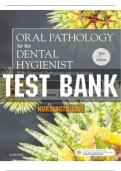,Chapter 01: Introduction to Preliminary Diagnosis of Oral Lesions
Ibsen: Oral Pathology for the Dental Hygienist, 7th Edition
MULTIPLE CHOICE
1. Which descriptive term is described as a segment that is part of the whole?
a. Bulla
b. Vesicle
c. Lobule
d. Pustule
ANS: C
A lobule is described as a segment or lobe that is part of a whole. A bulla is a large, elevated
lesion that contains serous fluid and may look like a blister. A vesicle is a small, elevated
lesion that contains serous fluid. Pustules are circumscribed elevations containing pus.
REF: Vocabulary, Clinical of Soft Tissue Lesions, page 1 OBJ: 1
2. A lesion with a sessile base is described as
a. an ulcer.
b. stemlike.
c. pedunculated.
d. flat and broad.
ANS: D
Sessile describes the base of a lesion that is flat and broad. An ulcer is a break in the surface
epithelium. A stemlike lesion is referred to as pedunculated. A pedunculated lesion is stemlike
or stalk-based (similar to a mushroom).
REF: Vocabulary, Clinical Appearance of Soft Tissue Lesions, page 1
OBJ: 1
3. Which condition is not diagnosed through clinical appearance?
a. Mandibular tori
b. Fordyce granules
c. Black hairy tongue
d. Compound odontoma
ANS: D
The compound odontoma is initially identified radiographically as a radiopaque area in which
tooth structure can be identified. No clinical component exists. Mandibular tori are identified
clinically as areas of exostosis on the lingual aspects of mandibular premolars. Fordyce
granules are yellow clusters of ectopic sebaceous glands diagnosed through clinical
appearance. Black hairy tongue is diagnosed clinically. The filiform papillae on the dorsal
tongue elongate and become brown or black. Causes include tobacco, alcohol, hydrogen
peroxide, chemical rinses, antibiotics, and antacids.
REF: Radiographic Diagnosis, page 9 OBJ: 3
4. Another name for geographic tongue is
, a. median rhomboid glossitis.
b. benign migratory glossitis.
c. fissured tongue.
d. black hairy tongue.
ANS: B
Benign migratory glossitis is another name for geographic tongue. Research suggests that
median rhomboid glossitis is associated with a chronic fungal infection from Candida
albicans. Sometimes the condition resolves with antifungal therapy. Fissured tongue is seen in
5% of the population. It is a variant of normal. Genetic factors are typically associated with
the condition. Black hairy tongue is caused by a reaction to chemicals, tobacco, hydrogen
peroxide, or antacids. The filiform papillae on the dorsal tongue become elongated and are
dark brown to black.
REF: Geographic Tongue, page 24 OBJ: 7
5. This bony hard structure in the midline of the hard palate is genetic in origin and inherited in
an autosomal dominant manner. The diagnosis is made through clinical appearance. Which
condition is suspected?
a. Palatal cyst
b. Torus palatinus
c. Mixed tumor
d. Ranula
ANS: B
A torus palatinus is developmental and bony hard and is found on the midline of the palate.
Diagnosis is made on the basis of clinical appearance. A palatal cyst appears radiolucent on a
radiographic examination and is not diagnosed through clinical appearance. A mixed tumor or
pleomorphic adenoma is a benign tumor of salivary gland origin, found unilaterally off the
midline of the hard palate. It is composed of tumor tissue that is not bony hard to palpation.
Ranula is a term used for a mucocele-like lesion that forms unilaterally on the floor of the
mouth.
REF: Torus Palatinus, page 21 OBJ: 4
6. The gray-white opalescent film seen on the buccal mucosa of 85% of black adults is a variant
of normal that requires no treatment and is termed
a. linea alba.
b. leukoedema.
c. leukoplakia.
d. white sponge nevus.
ANS: B
Leukoedema is a diffuse opalescence most commonly seen on the buccal mucosa in black
individuals. Linea alba is a ―white line‖ that extends anteroposteriorly on the buccal mucosa
along the occlusal plane. It is most prominent in patients who have a clenching or grinding
habit. Leukoplakia is a clinical term for a white lesion, the cause of which is unknown. White
sponge nevus is a genetic (autosomal dominant) trait. Clinically, it is characterized by a soft
white, folded (or corrugated) oral mucosa. A thick layer of keratin produces the whitening.
REF: Leukoedema, page 23 OBJ: 8
, 7. Which ncondition nmost nlikely nresponds nto ntherapeutic ndiagnosis?
a. Angular ncheilitis
b. Amelogenesis nimperfecta
c. Paget ndisease
d. Stafne nbone ncyst
ANS: n A
Angular ncheilitis nmost ncommonly nresponds nto nantifungal ntherapy nonce nnutritional
ndeficiencies nhave nbeen nruled nout. nAmelogenesis nimperfecta nis na ngenetic ncondition nassociated
nwith nabnormaln development nof nthe nenamel. nPaget ndisease nis na nchronic nmetabolic nbone
ndisease. nA nhighly nelevated nserum nalkaline nphosphatase nlevel ncontributes nsignificantly nto nthe
ndiagnosis. nA nStafne nbone ncyst nis ndetermined nthrough nsurgical ndiagnosis nin nwhich nentrapped
nsalivary ngland ntissue nisn
identified.
REF: n Therapeutic nDiagnosis, npage n18 OBJ: n 3
8. The ngingival nenlargement nin nthis npatient nwas ncaused nby na ncalcium nchannel
nblocker.n
Which nmedication nis nthe nlikely ncause?
a. Dilantin
b. Nifedipine
c. Quinidine
d. Clozapine
ANS: n B
Nifedipine nis na ncalcium nchannel nblocker. nDilantin nis nan nanticonvulsant nused nto nprevent
norncontrol nseizures. nQuinidine nis nan nantiarrhythmic nagent nused nto ntreat ncardiac narrhythmias.
nClozapine nis nan nantipsychotic nused nin nthe nmanagement nof npsychotic nsymptoms nin
nschizophrenia.
REF: n Historical nDiagnosis, nFig. n1.38, npage n17 OBJ: n 3
9. Radiographic nfeatures, nincluding ncotton-wool nradiopacities nand nhypercementosis,
narenespecially nhelpful nin nthe ndiagnosis n of
a. Paget ndisease.
b. dentinogenesis nimperfecta.
c. anemia.
d. diabetes.
ANS: n A
Paget ndisease nis na nchronic nmetabolic nbone ndisease. nRadiographically, ncotton-wool
nradiopacitiesn and nhypercementosis nare ncharacteristic nfeatures. nDentinogenesis nimperfecta nis na
ngenetic ncondition ninvolving na ndefect nin nthe ndevelopment nof ndentin. nAnemia, na ndecrease nin
nred nblood ncells, nrequires nblood ntests nto ndetermine nthe netiologic nfactors. nDiabetes nis na nchronic
ndisorder nof ncarbohydrate nmetabolism ncharacterized nby nabnormally nhigh nblood nglucose
nlevels.
REF: n Laboratory nDiagnosis, nFig. n1.40, npages n16, n18 OBJ: n 3
10. In ninternal nresorption, nthe nradiolucency nseen non nradiographic nexamination nis nusually
a. well ncircumscribed.
b. diffuse.




